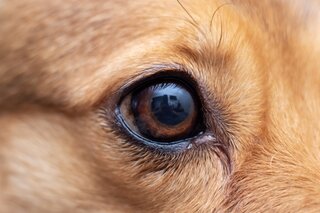
At Boschhoven Veterinary Clinic, we have a guest writer, Ella Sprengeman from Dogwooff.com, who has written a piece for us about the "indolent ulcer" and the "descemetocele," where she explains exactly what these conditions are and what the treatments involve.
As dog lovers, we are always concerned about the health and well-being of our loyal companions. Unfortunately, eye problems are common in dogs, and two conditions are the indolent ulcer and the descemetocele. But what exactly are these conditions, and how can we help our dogs with them?
INDOLENT ULCER
An indolent ulcer, also known as a "Boxer ulcer" due to its frequent occurrence in Boxers, is a type of corneal ulcer that stubbornly refuses to heal. This can be incredibly painful for your dog and often leads to significant discomfort.
SYMPTOMS OF AN INDOLENT ULCER
- Excessive tearing
- Squinting
- Redness
- Cloudiness of the cornea
Indolent ulcers typically occur due to a tear in the attachment of the upper layer of the cornea to the underlying layers. This means that the ulcer keeps reopening, even when it tries to heal. It is a frustrating and very painful condition for both the dog and the owner.
TREATMENT OF INDOLENT ULCER
Treating an indolent ulcer often requires a procedure by the veterinarian. A common method is to remove the loose epithelium (top layer of the cornea) and stimulate healing through a procedure called "grid keratotomy." This involves making small scratches on the cornea to encourage healing.
Additionally, your veterinarian will prescribe eye drops and ointment to prevent infection, promote healing, and relieve pain. A bandage lens may also be placed to support healing and comfort. It is crucial to follow your veterinarian's instructions carefully and bring your dog back for follow-up visits to ensure that the ulcer is healing properly.
DESCEMETOCELE
A descemetocele is a serious condition where a corneal ulcer, due to trauma or infection, becomes so deep that it reaches Descemet's membrane, the last layer before the inside of the eye. This is a medical emergency because the eye is at risk of perforation, which can lead to loss of the eye or severe infections. Unlike the indolent ulcer, it is often not painful.
SYMPTOMS OF A DESCEMETOCELE
- Often a bluish haze over the eye with a dark, clear pit in the center
- Often not painful
- Sometimes, depending on the size of the ulcer, a visible bulge on the cornea
TREATMENT OF DESCEMETOCELE
The treatment of a descemetocele is usually surgical. Often, emergency surgery is necessary to repair the cornea and prevent further damage. This may involve a corneal transplant or a flap surgery, where a piece of tissue from another part of the eye is used to cover and protect the damaged area while it heals.
After surgery, your dog will likely require intensive care, including regular administration of eye drops and medications to prevent infections and support healing.
It is important to always be alert to changes in your dog’s behavior and eyes. Regular check-ups with the veterinarian can help detect and treat eye problems early before they become severe.
Ella Sprengeman - Dogwooff.com



